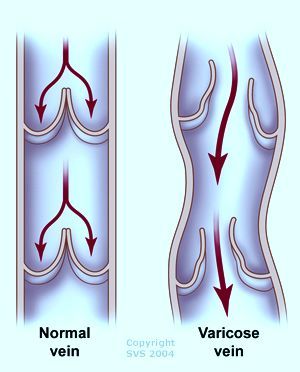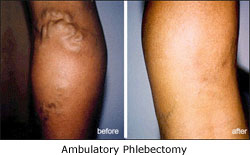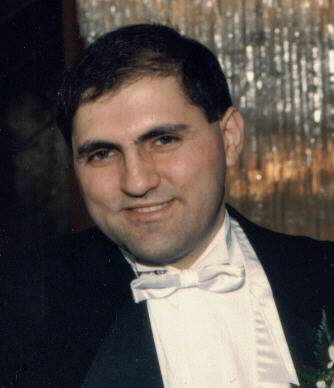| .
Hazlet Office
Eatontown Office
966 Hwy 36
142 Hwy 35, Suite 106
Hazlet NJ 07730
Eatontown NJ 07724
Office
Phone:
(732) 847-3461
Office
Fax:
(732) 284-4272
Office Hours: Monday and Thursday, 8
a.m. to 5 p.m.
What
are Varicose
Veins
?
Varicose
veins are swollen veins that you can see through your skin. They often
look blue, bulging, and twisted. Left untreated, varicose veins
may worsen over time. Large varicose veins can cause aching and feelings
of fatigue as well as skin changes like rashes, redness, and sores.

There are three kinds of veins in our body (supperficial veins,
perforating veins, and deep veins). Generally, the superficial veins
connect to the deep veins directly or though the perforating veins.
Although we normally treat superficial vein disease, any of the veins
can cause problems requiring treatment.

Veins return the oxygen poor blood back to the heart for
recirculation. To achieve this, most veins in the body have valves which
prevents blood from flowing in the opposite direction. During muscle
movement the valves open, thus allowing blood to flow towards the heart.
During periods of rest or standing these valves close; thus preventing
the blood from flowing back down the vein in to the legs form which it
came.
When the valves become stretched or damaged, the normal return of
blood to the heart is interrupted and the diseased veins begin to dilate
over time.
Spider veins are
mild varicose veins. They look like a nest of red or blue lines just
under your skin. Spider veins are not a serious medical problem, but
they can be a cosmetic concern to some people.
What are the symptoms?
- Mild symptoms
- heavy feeling
- tired
- restless
- achness
- night cramps.
- Severe symptoms
- skin color change
- open sores
- swelling of the leg
- dermatitis
- deep venous thrombosisi (DVT). This may cause a sudden,
severe leg swelling. If present, it is a serious condition that requires immediate
medical attention.
What causes varicose veins?
High blood pressure inside your superficial leg veins causes varicose
veins. Risk factors that worsen your chances of having varicose veins
include:
- standing or sitting for too long may worsen your
symptoms.
- smoking
- being overweight
- deep venous thrombosis
- Pregnancy increases the risk of developing varicose veins,
but the veins often return to normal within 1 year after childbirth. Women who have multiple pregnancies may develop permanent varicose
veins.
What tests will I need?
A ultrasound of the veins will
complement your doctors physical examination and will help to formulate
a treatment plan. It will also allow the doctor to determine if the
varicose vein is an isolated problem or part of a broader problem.
How are varicose veins treated?
All patients regardless of severity should try leg elevation above the level of your
heart 3 or 4 times a day for about 15 minutes at a time. In addition
basic compression stockings with varying
strengths may help reduce the leg swelling, heavy feeling and leg
fatique. For mild disease gentile compression stockings using 12-15 mmHg
may be of benefit. For moderate disease higher compressions can be
discussed with your doctor.
 Compression Stockings Compression Stockings
Compression stockings are elastic stockings that
squeeze your veins and stop excess blood from flowing backward. Wearing
these stockings daily at the correct pressure will help heal wounds and prevent
them from returning.
When these kinds of treatments alone do not relieve your varicose
veins, you may require a surgical or minimally invasive treatment,
depending upon the extent and severity of the varicose veins. These
treatments include sclerotherapy, vein stripping, and laser
treatment.
 Sclerotherapy Sclerotherapy
This is a chemical injection designed to chemically irritate and scar your veins from the
inside out so your abnormal veins can then no longer fill with blood. Your body will eventually
absorb the veins that received the injection.
Most people need a few treatments (2-4
treatments) to obtain the best results. In patients with milder cases,
1-2 will suffice. The treatments are more when there are more veins or
slightly larger veins. For patients with multiple spider veins, up to
15-20 injections can be done at each seating. Sclerotherapy treatments
are generally done in monthly intervals.

Laser Treatment
Laser treatment is the insertion of a tiny fiber into the vein with
the intent of destroying the lining of the diseased vein. The vein closes and your body eventually absorbs it.
Commonly asked questions
- How long does it take? The procedure takes approximately on
hour. After the procedure, you can go home with a friend
or
relative but are not allowed to operate any machinery for 24 hours.
- Is the
procedure painful? There is mild pain during the procedure which
is controlled with the local anesthetic at the skin level.
- How quickly
after treatment can I return to normal activities? The
majority of individuals resume their normal activities in a day.
Continued walking and a resumption of normal activities is highly
encouraged. For those into sports and heavy lifting, a delay of 2 weeks should be appropriate.
- How soon
after treatment will my symptoms improve? Most
patients report marked improvement in their symptoms within 1-2 weeks
following the procedure. The cosmetic appearance usually takes a few
more months.
- What are
side effects of the procedure? Patients
report minimal to no scarring, bruising, or swelling following the procedure. Most of these disappear in 1-2 weeks.
- Are there
any potential risks and complications associated with the closure
procedure? As
with any medical intervention, potential risks and complications exist
with the procedure. Potential complications include:
- vessel
perforation
- thrombosis
- pulmonary
embolism
- phlebitis
- hematoma
- infection
- paresthesia
(numbness or tingling)
- Skin
burn.
- What
happens to the treated vein left behind in the leg? The
treated vein collapses and becomes fibrous tissue.
- Is it
covered by my insurance? If
the patient with varicose vein has symptoms, many insurance companies
cover the cost of the procedure in part or in full. However,
most insurance companies want a trial of stockings and exercise before
surgery is undertaken.
 Ambulatory
Phlebectomy Ambulatory
Phlebectomy
Ambulatory
phlebectomy is a method of removing varicose veins on the surface of the
legs. It is done in the office under local anesthesia. This procedure
involves making tiny punctures or incisions through which the varicose
veins are removed. After
treatment, a compression bandage and/or compression stocking are worn. The patient is able
to walk following the procedure.
Greater
and lesser saphenous vein stripping
Vein
stripping involves tying off of the upper end of a problem vein and then
removing the vein. Vein stripping is performed in an operating room.
This procedure is done under spinal or general anesthesia and is chosen
only when an alternative lesser invasive therapy is not appropriate.
.
How can you reach us?
To
speak with a staff member, call between 9
a.m. to 5 p.m., Monday
through
Thursday.
Phone:
(732)
847-3461.
|







 Ambulatory
Phlebectomy
Ambulatory
Phlebectomy